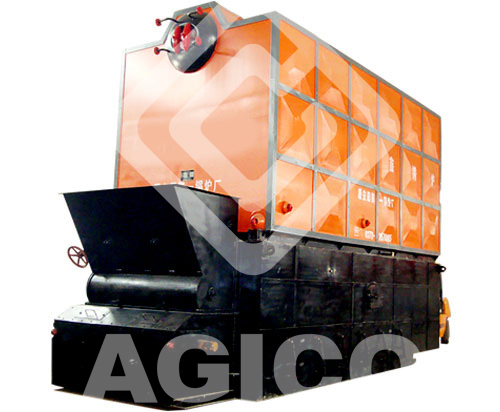The boiler consists of convection bank and the lengthways placed upper& lower boiler barrels with arranged water walls of Φ51×3. Steam-water separator and continuous blowdown device are installed in the upper boiler barrel; periodic blowdown device is installed in the lower boiler barrel; and the economizer is placed at the tail of the boiler.
GC-DZ Series Biomass Boiler
- Compact structure, small floor area, monolayer boiler room, low investment of capital construction;
- Easily assembled boiler, short installation period, low installation cost;
- Rationally designed heating surface, smooth water circulation, fast heating up, higher water pressure and thermal efficiency;
- Air inlet chamber is separate, and each air inlet can be adjusted independently. Electrodeless speed governing fire grate can burn fuel sufficiently.
- Electronic control is equipped with the automatic control& detecting instrument. It owns the advantages of great automaticity, safety and simple handling.
Selection of fuel
Feedstocks of biomass energy recycling system are as follows: biomass residue such as rice husk, straw and sawdust from agriculture and forestry production; that via refining sugar, alcohol and biomass fuel with industry and agriculture material in agriculture and forest chemical industry and food industry. According to analyses on fuel characteristics, heating power model can be built and treated systematically with modern advanced thermal energy technology and steam and hot water can be produced to contribute to central heating, industrial process heating and electric power generation respectively. Second-class soft coals, peanut shells and biomass briquettings can be selected to be fuel.
a.Basis of calculation
To ensure the calorific value of various kinds of fuel, lower calorific value shall be seen as the benchmark to calculate costs. 13kg pressure per ton of steam takes 650,000 kcal in total; for the natural gas, each standard cubic square costs $0.75 taking 8,400 kcal(the price lies in specific lower calorific value in different areas, that is to say, the price hereby mentioned is just taken as the reference price. ) with the thermal efficiency of 90%; the lower calorific value of the 0# diesel is 11,000 kcal/kg, with the price $1447/ton (reference price $1.22/L with the density of 0.84)and thermal efficiency 90%; that of the wood pellets remains 4,000kcal, with the price $175/ton and thermal efficiency of 85%; for rice husk and straw briquetted fuel, it’s 3,500 kcal/kg, with the price $150/ton and thermal efficiency of 85%; the prices for costs are all DDP (Delivered Duty Paid)price, excluding that for 0# diesel which refers to tank cession price.
b.Calculation of cost for generating 1 ton steam
Gas:4.5× [650000÷ (8400×90%)] =$64.5
Diesel oil 0#: 8680× [650000÷ (11000×90%) ×1000] =$95
Wood pellet: 1050× [650000÷ (4000×85%) ×1000] =$33.5
Rice husk and straw: 900× [650000÷ (3500×85%) ×1000] =$33
c.Other cost
If we take the steam boiler with production capacity of 8 tons and such fuel as biomass and natural gas, $13.33 shall be counted in per hour as extra payment for electricity fee, cost of labor and facility depletion expenses. With the invisible expenses included, other costs may rise by $20 at most every hour (as to the oil burning boiler, the costs can be calculated half of that for the biomass boiler.) Therefore, given a steam boiler with the production capacity of 8 tons, 24 hours operation in the period of 300 days, we can estimate the costs differences for yearly operation in oil burning boilers, gas boilers and biomass boilers.


